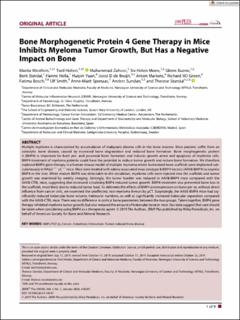| dc.description.abstract | Multiple myeloma is characterized by accumulation of malignant plasma cells in the bone marrow. Most patients suffer from an osteolytic bone disease, caused by increased bone degradation and reduced bone formation. Bone morphogenetic protein 4 (BMP4) is important for both pre‐ and postnatal bone formation and induces growth arrest and apoptosis of myeloma cells. BMP4‐treatment of myeloma patients could have the potential to reduce tumor growth and restore bone formation. We therefore explored BMP4 gene therapy in a human‐mouse model of multiple myeloma where humanized bone scaffolds were implanted subcutaneously in RAG2−/− γC−/−mice. Mice were treated with adeno‐associated virus serotype 8 BMP4 vectors (AAV8‐BMP4) to express BMP4 in the liver. When mature BMP4 was detectable in the circulation, myeloma cells were injected into the scaffolds and tumor growth was examined by weekly imaging. Strikingly, the tumor burden was reduced in AAV8‐BMP4 mice compared with the AAV8‐CTRL mice, suggesting that increased circulating BMP4 reduced tumor growth. BMP4‐treatment also prevented bone loss in the scaffolds, most likely due to reduced tumor load. To delineate the effects of BMP4 overexpression on bone per se, without direct influence from cancer cells, we examined the unaffected, non‐myeloma femurs by μCT. Surprisingly, the AAV8‐BMP4 mice had significantly reduced trabecular bone volume, trabecular numbers, as well as significantly increased trabecular separation compared with the AAV8‐CTRL mice. There was no difference in cortical bone parameters between the two groups. Taken together, BMP4 gene therapy inhibited myeloma tumor growth, but also reduced the amount of trabecular bone in mice. Our data suggest that care should be taken when considering using BMP4 as a therapeutic agent. © 2019 The Authors. JBMR Plus published by Wiley Periodicals, Inc. on behalf of American Society for Bone and Mineral Research. | en_US |

